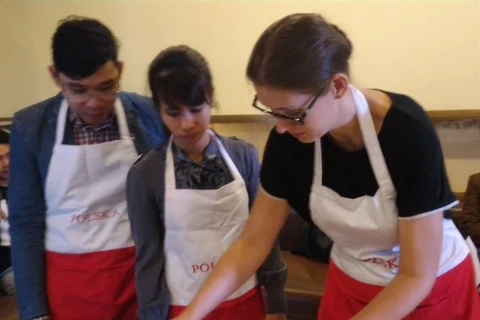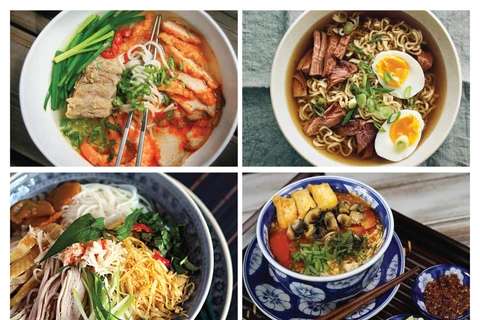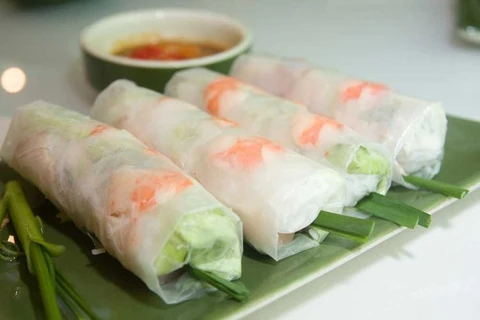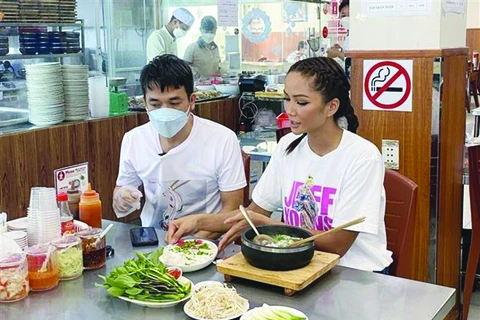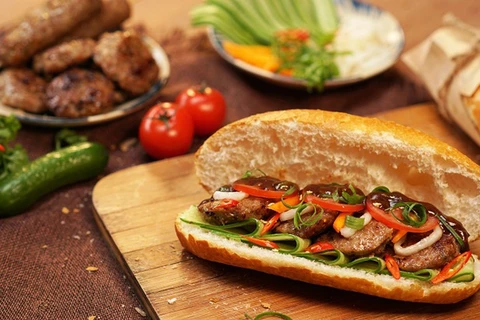Hanoi (VNA) - World-renowned magazine Vogue has published an article recommending 29 delicious Vietnamese dishes that must be tried when having the opportunity to visit Vietnam, beyond famous pho (noodle) and banh mi (bread).
“When we think about Vietnamese dishes, complex flavors and contrasting textures come to mind,” author Christina Liao wrote.
Below are the dishes to try when travelers make their way to a Vietnamese restaurant or head to Vietnam on vacation.
Banh xeo and banh khot
The first is a type of savory crepe made from rice flour and turmeric powder (hence the yellow hue) and is stuffed with pork, shrimp, and bean sprouts. Wrap it up in lettuce, add some herbs to it, and dip it into some fish sauce before taking a bite into this crispy delight. Banh khot is similar to banh xeo, using the same batter, but it resembles a mini pancake with a single shrimp in the center. These bite-size medallions are cooked in a special cast-iron plate so that the outside is crunchy and the inside is fluffy.
Bun rieu
There are a few variations of this noodle soup dish, but the foundation of it is a crab and tomato broth. The crustaceans produce a piquant aroma while the red vegetable adds a layer of acidity and hint of sourness to the soup. Vermicelli is often the noodle of choice and toppings can include meatballs, pork knuckles, fried tofu, fish, snails, and blood cubes.
Goi cuon
We all know the fried spring roll (cha gio), but its “fresh” counterpart is a much lighter and healthier appetizer alternative. Slices of pork, shrimp, lettuce, mint, and vermicelli noodles are neatly wrapped up in a translucent rice paper before being dunked into a hoisin-peanut dip.
Thit kho to
For this addictive caramelized dish, chunks of pork belly are slowly braised in sugar and fish sauce until fork-tender. Served in a clay pot, it’s best scarfed up with some rice and boiled vegetables dipped into the sauce. For those who aren’t a fan of the fatty meat and prefer seafood, try ca kho to (usually made with catfish) instead.
Bun bo Hue
Sometimes just referred to as bun bo, the “Hue” denotes its origin city. The hearty beef broth is prepared with plenty of lemongrass and then seasoned with shrimp paste, sugar, and chili oil. A round, slippery rice noodle with a bit of chewiness to it is used for the dish, which is then topped off with a variety of meats and served with lime and herbs. The result is a nice balance of spicy, sour, sweet, and salty, all in one bowl.
Rau muong xao toi
Morning glory, also known as water spinach, is a common vegetable found in Vietnam as the country’s tropical climate creates ideal conditions for its growth. The best way to have it is stir-fried with copious amounts of garlic (and maybe a hint of fish sauce and sugar)—keeping it simple sometimes leads to outstanding results.
Cao lau
This Hoi An noodle specialty is a must when visiting the ancient town. It’s said that the water used to make the chewy rice noodle comes from the archaic Ba Le well and that its brown color comes from a lye solution made from the ash of a specific type of tree found on the Cham Islands just off the coast. Topped with sliced pork, crunchy rice crackers, spices, and a handful of fresh herbs and lettuce with just a sprinkling of broth at the bottom of the bowl, it’s an incredible medley of flavors and textures.
Banh cuon
These delicate rice noodle rolls may look familiar if you’ve had cheung fun at a dim sum restaurant before. When it comes to banh cuon, these parcels are filled with minced pork and wood ear mushroom, then topped with a smattering of fried shallots and dipped into fish sauce. Make sure to eat them while they’re hot and soft.
Bo luc lac
Also known as shaking beef to describe the tossing of the meat in a wok, cubes of beef are sautéed with garlic, onions, black pepper, and soy sauce. Served with a salad of lettuce, tomatoes, and cucumber, it’s a simple but delicious entrée.
Bun thit nuong
Grilled marinated pork dressed with scallions in oil and crushed peanuts set on top of a bed of vermicelli noodles with a handful of herbs, pickled daikon, and carrots sounds deceivingly ordinary, but is actually an all-star dish. Add some fried spring rolls, drizzle some fish sauce over the entire bowl, mix everything up, and you’ll be good to go.
Bun cha
Hailing from Hanoi, bun cha is one of the most popular dishes in the capital. Small patties of seasoned pork and slices of marinated pork belly are grilled over charcoal before they’re submerged in a bowl of nuoc cham–based sauce. A basket of herbs, plate of vermicelli noodles, and a side of cha gio accompany the meat, all of which are meant to be combined and eaten together.
Goi xoai
If you’re craving something fresh and light, then this vibrant salad is just what you’re looking for. Julienned carrots, onions, and unripe mango are mixed with herbs like mint and basil before being marinated in a nuoc cham and lime–based sauce. The salad is then topped with either boiled shrimp or dried beef and decorated with a generous helping of fried shallots and roasted peanuts to add some crunch and depth to the plate.
Canh chua
This refreshing sweet and sour soup consists of a tamarind broth and is typically made with fish, pineapple, tomatoes, and vegetables like okra and elephant ear. It’s somewhat evocative of tom yum, but without the lime and lemongrass.
Thit luoc tom chua
Boiled pork belly, a heap of herbs and vegetables, and sour shrimp sauce (or fermented shrimp paste) are the makings of this Vietnamese staple. Ask for some vermicelli noodles and rice paper if you like to DIY your own spring rolls.
Hen xuc banh trang
When it’s time to kick back with a beer, make sure you order this plate of stir-fried baby clams. Crunchy sesame rice crackers act as both vessel and utensil, making this a great finger food with a contrast in both textures and flavors.
Banh beo
For those who enjoy the sticky and chewy textures of mochi, banh beo might just be the savory rice cake you’ve been waiting for. These miniature discs have dimples in the center that are filled with ingredients such as dried baby shrimp, scallions, and fried shallots.
Banh bao
If visitors have ever had Chinese dai bao, then banh bao will be instantly recognizable. These large steamed buns frequently sold by street vendors are filled with minced meat, a quail egg, sausage, and vegetables. They’re great for breakfast or when visitors are on the move.
Chao
Rice porridge is an omnipresent dish in Asian cuisine. Pick from a number of different toppings to spruce it up. Chao can be eaten with many types of meat such as pork, chicken, heart. This is a particularly good dish for sick people.
Com tam
Also known as broken rice, these fractured grains are eaten with your preferred protein. Grilled pork, prawns, or beef sit alongside accompaniments such as fresh and pickled vegetables, an over-easy egg, crispy spring rolls, and thinly shredded pork skin. Pour a healthy dose of fish sauce over the plate and you’ve got yourself a superb meal.
Mi xao mem
The Chinese influence is really noticeable in this stir-fried egg noodle dish. Cooked in soy sauce and oyster sauce with a mix of vegetables and choice of protein, it certainly isn’t the most bizarre thing on the menu, but it’s a good starter for anyone who wants to ease their way into unfamiliar territory.
Ga tan
If you’re looking for a chicken soup to cure all ailments, then ga tan is just the tonic you need. Chunks of chicken are stewed with a variety of vegetables and herbs, giving the broth a dark hue that admittedly is not the most appealing color when it comes to food, but it’ll surely warm you up from the inside out. This is a popular Hanoi street food dish and can be found everywhere throughout the city.
Hu tieu
Another popular noodle dish, particularly in southern Vietnam, hu tieu has a number of variations that can be either served in a broth made from pork bones or dry with sauce. It’s most frequently served with tapioca noodles, but some shops may use rice or egg noodles. Toppings include pork, beef, chicken, and seafood, along with a mix of herbs and vegetables.
Xoi
While sticky rice in most cuisines acts as a side dish, the Vietnamese version is a meal in itself and can be either savory or sweet. And don’t be surprised if it comes out in bright hues, especially in the northern region where xoi ngu sac (five-colored sticky rice) is cooked with herbs and the various pigments symbolize five elements: land, wood, fire, water, and metal.
Bot Chien
Inspired by a Chaozhou snack, bot chien are pan-fried rice cakes with a thin layer of egg. These savory and chewy bites are usually topped with fresh scallions and are served with a tangy soy sauce. It’s a popular street food and you’ll often find them in the evenings at many stalls.
Lau
Family-style dining is an inherent part of Asian culture and one of the best ways to partake in a joyous gathering is over lau. The Vietnamese take on hot pot often features a sweet and sour broth that’s been seasoned with lime, lemongrass, tomatoes, chili, and aromatics. A cornucopia of raw ingredients like thinly sliced meat, vegetables, seafood, tofu, and noodles are cooked in the bubbling cauldron, then either eaten as is or dipped into a sauce of your choosing.
Bo ne
The Vietnamese version of steak and eggs, bo ne is a brunch favorite. Pulling some inspiration from the French, the marinated steak is cooked with tomatoes, onions, eggs, and pâté on a sizzling cast iron skillet with butter. The dish is often served with a toasted baguette.
Mi Quang
Originating from the central province of Quang Nam, this dish uses flat rice noodles that have been dyed with turmeric and is served with just a touch of concentrated pork and shrimp broth. It’s then topped off with a variety of protein, but most typically pork and shrimp, along with a mix of herbs and something crunchy, usually in the form of either crushed roasted peanuts or toasted sesame rice crackers.
Bo kho
Inspired by Chinese braised beef stew, the Vietnamese version is even richer in aromatics, the magazine said.
The broth, which is simmered for hours, has a thinner consistency and is made with lemongrass, star anise, cloves, cinnamon, onions, and garlic. Chunks of beef are seared prior to being finished off in the pot with carrots until both are fork-tender. To complete the dish, a toasted baguette is provided to help soak up the soup./.




